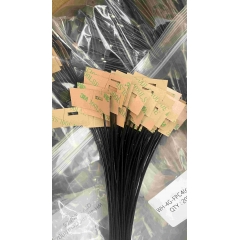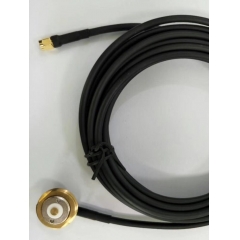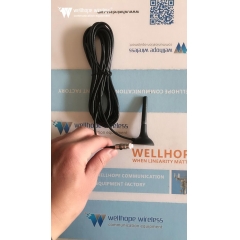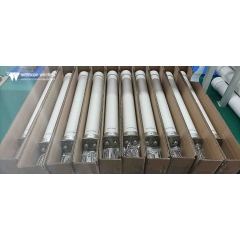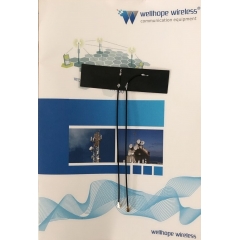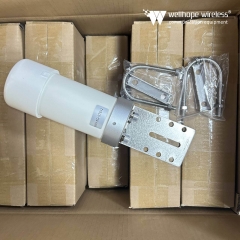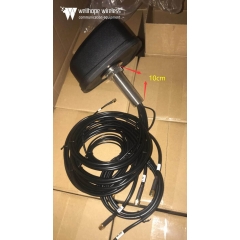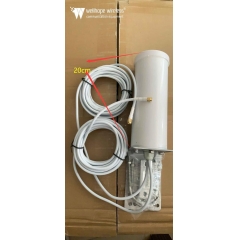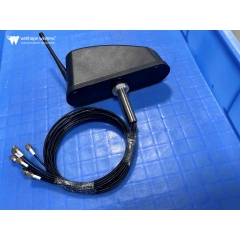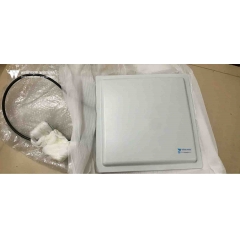Antenna technology in mobile communications
2021-10-11 www.whwireless.com
Estimated 10 minutes to finish reading
The antenna is an indispensable component of mobile communication and plays a very important role, it is located between the transceiver and the electromagnetic wave propagation space and achieves an effective energy transfer between the two. By designing the radiation characteristics of the antenna, the spatial distribution of electromagnetic energy can be controlled to improve resource utilisation and optimise network quality. Especially in the development of 3G, Smart Antenna has become a hot spot in recent international mobile communication research.
A, mobile antenna using the key technology
⒈ symmetric oscillator and antenna array
The antenna form used in the current mobile communication is mainly line antenna, that is, the length of the antenna radiation body l is much larger than its diameter d line antenna is based on symmetrical oscillator. When the wavelength determined by the frequency change of the high-frequency current through the wire is much greater than the length of the wire, it can be considered that the amplitude and phase of the current on the wire is the same, only its value with time t for sinusoidal changes, this short wire is called current element or Hertzian dipole, it can be used as an independent antenna or become a complex antenna component unit. Complex antenna electromagnetic field in space can be seen as the result of the iterative addition of electromagnetic fields generated by many current elements. The radiated power of a current element is the average of the electromagnetic energy radiated outwards through the sphere per unit time. The energy of the radiated field will no longer be returned to the wave source, so it is an energy loss for the source. Introducing the concept of a circuit, we use the equivalent resistance to express this part of the radiated power, then this resistance is called the radiation resistance, the radiation resistance of the current element is :
RΣ = 80π2(l/λ)2(l)
The directional diagram of the current element can be obtained by integrating the calculation. When l/λ < 0.5, as l/λ increases, the directional map becomes sharp and has only the main flap, which is perpendicular to the oscillator axis; when l/λ > 0.5, a secondary flap appears, and as l/λ increases, the original secondary flap gradually becomes the main flap, while the original main flap becomes the secondary flap; when l/λ = 1, the main flap disappears. This change in directionality is mainly caused by the change in current distribution on the oscillator.
Multiple symmetrical oscillators combined to form the antenna array. According to the symmetrical oscillator arrangement, the antenna array can be divided into linear array, plane array and three-dimensional array, etc., different arrangements have different array factors. According to the directional multiplication principle, using the same symmetrical oscillator as the antenna array of the unit antenna, as long as the alignment position or feed phase, you can get different directional characteristics. Mobile communication in the base station high gain omni-directional antenna is the oscillator for co-axial arrangement, compression of the vertical surface of the beam width, and the radiation energy concentrated in the direction perpendicular to the oscillator, in order to improve the gain of the antenna.
The directional characteristics of the antenna and gain
The directional characteristics of the antenna can be used to describe the directional chart, but the number to express the concentration of electromagnetic energy of the antenna radiation is often used directional coefficient D. It is defined as: in the same radiation power, directional antenna in the maximum radiation direction far area of a point of power flux density (unit area through the electric field power, is proportional to the square of the electric field strength) and no directional antenna in the point of power flux density. density of the ratio.
And because the loss of the antenna itself is very small, can be considered that the antenna's radiation power is small, can be considered the world's radiation power equal to the input power, that is, the antenna efficiency η = 100%, then the antenna gain G = η - D = D, that is, the antenna gain and antenna directional coefficient in the value is equal.
To improve the gain of the antenna, in the case of maintaining the same radiation characteristics on the horizontal plane, mainly rely on reducing the width of the vertical plane radiation flap. Vibrator length change on the gain is very limited, antenna array is currently the main means to achieve high gain. Linear array is the simplest and most practical omnidirectional antenna array, in line with the axis of the vibrator on the same axis, according to a certain interval distance to arrange a number of radiation oscillator, can be in the plane perpendicular to the axis of the enhanced radiation field. However, to obtain the best results, the spacing between the oscillators and the feed phase must be properly selected. As a radiation unit, can use half wave oscillator or in the horizontal plane has omnidirectional performance of other radiation sources, such as folded oscillator or a variety of coaxial antenna, etc.. Common axis antenna array is the base station commonly used high gain antenna, it requires the radiation unit to get the same amplitude and phase feed, feed and series feed two kinds of feed. Another high gain omni-directional antenna is a number of directional antennas are oriented in different directions, forming an approximation of omni-directional radiation. However, when the antenna is to be erected in the middle section of a large tower, the directionality of the co-axial antenna array will be destroyed due to the influence of the tower reflection, when the directional antenna array arranged reasonably around the tower can solve this problem. More importantly, when frequency multiplexing in cellular communication system, directional antenna can better reduce the same and neighbouring frequency interference and improve the frequency multiplexing rate. 120o angle reflector or 120o plane reflector can be used in 120o sector cell, 60o angle reflector can be used in 60o sector cell.
Omni-directional antenna is generally used for mobile user number less network, or user density lower area, such as suburban, rural areas, etc., its horizontal directional figure should be 360o, vertical half power beam width according to the antenna gain can have 13o or 6.5o. directional antenna is generally used for mobile user density higher area, such as urban, station, commercial centre, etc., its horizontal half power Beam width generally 65o, 90o, 105o, 120o, vertical half-power beam width according to the antenna gain can have 34o, 16o or 8o, etc.
The use of diversity technology to improve the gain
Due to the poor propagation environment, the wireless signal will produce depth fading and Doppler shift, etc., so that the reception level down to the thermal noise level near, the phase also produces random changes over time, which leads to communication quality decline. In this regard, we can use diversity reception technology to mitigate the impact of fading, gain diversity and improve the reception sensitivity. Diversity antenna has spatial diversity, directional diversity, polarization diversity and field component diversity. Spatial diversity is the use of multiple receiving antennas to achieve. In the transmitting end using a pair of antennas to transmit, and in the receiving end using multiple antennas to receive. The distance between the antennas at the receiving end d ≥ λ/2 (λ for the working wavelength), to ensure that the decay characteristics of the receiving antenna output signal is independent of each other, that is, when the output signal of a receiving antenna is very low, the output of other receiving antennas is not necessarily in this same moment also appear low amplitude phenomenon, by the corresponding merging circuit to select the signal amplitude, the best signal-to-noise ratio all the way, to get a The signal amplitude and signal-to-noise ratio are selected by the corresponding merging circuit to obtain a total receiving antenna output signal. This reduces the effect of channel fading and improves transmission reliability. This technique is used in analogue frequency division mobile communication systems (FDMA), digital time division systems (TDMA) and code division systems (CDMA).
The advantage of spatial diversity reception is the high diversity gain, but the disadvantage is that a separate receiving antenna is required. In order to overcome this disadvantage, in recent years and the production of directional dual polarisation antenna. In mobile communication, two in the same place, polarization direction orthogonal to each other antennas issued by the signal shows a mutually uncorrelated fading characteristics. The use of this feature, in the same place in the transmitter on the vertical polarization and horizontal polarization two pairs of transmitting antennas, in the same place in the receiver on the vertical polarization and horizontal polarization two pairs of receiving antennas, you can get two road fading characteristics of the polarization component Ex and Ey unrelated. the so-called directional dual polarization antenna is the vertical polarization and horizontal polarization two pairs of receiving antennas integrated into a physical entity, through the polarization of the diversity of reception to achieve the effect of spatial diversity reception, so polarization diversity is actually a special case of spatial diversity. The advantage of this method is that it requires only one antenna, which is compact and space-saving. The disadvantage is that its diversity reception effect is lower than that of spatial diversity reception antennas, and because the transmit power has to be distributed to the two antennas, it will cause a 3dB signal power loss.
The diversity gain depends on the uncorrelated characteristics of the base station antennas and is achieved by separating the antenna positions in the horizontal or vertical direction. The spatial location separation ensures that the two receiving antennas receive the mobile station signals from different paths, and also makes the two antennas meet the requirements of a certain degree of isolation. If cross-polarisation antennas are used, the same isolation requirements need to be met. For polarization diversity of dual polarization antenna, antenna in two cross-polarization radiation source orthogonality is the main factor to determine the wireless signal uplink diversity gain. The diversity gain depends on whether the two cross-polarised radiation sources in the dual-polarised antenna provide the same signal field strength in the same coverage area. The two cross-polarised sources are required to have good orthogonal characteristics and maintain good horizontal tracking characteristics throughout the 120o sector and switching overlap, replacing the coverage achieved by the spatial diversity antenna. Most cross-polarised antennas have good electrical characteristics in the direction of the main flap of the antenna field diagram, but for the base station antenna, it is also required to maintain good cross-polarisation characteristics at the edge of the cell and within the switching overlap. In order to obtain the coverage effect, the antenna is required to have a high cross-polarisation resolution in the whole sector range. Dual-polarized antenna in the whole sector of the orthogonal characteristics, that is, the two diversity receive antenna port signal uncorrelated, determine the total dual-polarized antenna diversity effect. In order to get a good signal uncorrelated characteristics in the dual-polarized antenna of the two receiving ports, the isolation between the two ports usually requires more than 30dB.
The diversity antenna separates the multipath signals so that they are not correlated with each other, and then the separated signals are combined by combining techniques to obtain the maximum signal-to-noise ratio gain. Commonly used merging methods are selective merging, switching merging, maximum ratio merging, equal gain merging, etc., this paper will not be discussed in detail.
Second, intelligent antenna technology
⒈ traditional antenna limitations
In recent years, with the continuous development of communication needs, smart antenna technology has become the focus of attention, it helps wireless network operators to achieve 2 very valuable purposes: improve the higher data transmission rate and increase the network capacity. In GPRS, EDGE and 3G networks, operators are beginning to use wireless networks to offer packet data services to their subscribers. As with voice services, data services also require a certain quality of radio signal to achieve the required transmission rate, which depends on the carrier-to-interference ratio (C/I) of the network. A low C/I ratio will seriously affect the transmission rate and quality of service; in the middle and late stages of the GSM network, the system capacity is increasing, cells are splitting up and the consequent increase in interference is preventing further increases in system capacity, so the traditional omni-directional and directional antennas are no longer sufficient. Smart antennas use digital signal processing technology to generate a spatially directed beam, providing each user with a narrow directional beam so that the signal is transmitted and received in an effective directional area, making full use of the effective transmit power of the signal and reducing the electromagnetic pollution and mutual interference caused by the omnidirectional emission of the signal, thus improving the carrier-to-dry ratio, and with an improved carrier-to-dry ratio, higher data transmission rates and greater network capacity.
Interference is an important factor in the performance and capacity limitations of cellular systems, causing crosstalk, call loss or call signal degradation and user distraction, and most importantly, it limits the tightness of the operating reusable frequencies and therefore the extent to which traffic carrying capacity can be extracted from the fixed RF spectrum. Interference can come from another mobile terminal, other cellular sites operating on the same frequency, or out-of-band RF energy leaking into the allocated spectrum. The most common types of cellular interference are co-channel interference and adjacent channel interference. Co-channel interference is caused by emissions from non-adjacent cells using the same frequency. This interference is most noticeable close to the cellular boundary, when physical separation from neighbouring cells using the same frequency is at its lowest level. Adjacent channel interference is caused by leakage from neighbouring cells using the same frequency to the user's channel. This occurs in adjacent channels where the user is operating in close proximity to the telephone subscriber receiver, or where the user's signal is significantly weaker than that of the adjacent channel user. For the user, a higher C/I ratio means lower interference, fewer dropped calls and improved audio quality; for the operator, a higher C/I allows for longer signal distances and tighter frequency multiplexing, therefore increasing the capacity of the overall system.
Peal Multibeam Smart Antenna
Smart antenna is an antenna array, it consists of N antenna units, each antenna unit has M sets of weighters, can form M different directions of the beam, the number of users M can be greater than the number of antenna units N. According to the shape of the antenna direction map used, smart antenna can be divided into 2 categories: multi-beam antenna and adaptive antenna array.
Multi-beam antennas use multiple parallel beams to cover the entire user area, with each beam pointing in a fixed direction and the beam width varying with the number of elements in the array. As the user moves through the cell, the base station selects a different beam accordingly to make the received signal the strongest. However, as its beams are not arbitrarily directed, they can only be partially matched to the current transmission environment. When the user is not at the centre of the fixed beam, but at the edge of the beam, and the interference signal is at the centre of the beam, the reception effect is the worst, so the multi-beam antenna cannot achieve the best signal reception. However, compared with the adaptive antenna array, it has the advantages of simple structure, no need to judge the direction of arrival of user signals and fast response time. More importantly, the same beam from the uplink can also be used for the downlink, thus providing gain on the downlink as well. However, due to sector distortion, such as the difference in directional maps between beams, the gain obtained by a multibeam antenna is non-uniformly distributed with respect to angle. It can sometimes reach 2dB difference between beams, and there is also the possibility that they lock in the wrong beam due to multipath or interference, as they cannot suppress interfering signals that are in the same beam as the useful signal. Multi-beam antennas, also known as beam switching antennas, can actually be seen as a technique between sectoral directional antennas and fully adaptive antennas. Multi-beam antenna is worth studying the following content: how to divide the airspace, that is, to determine the problem of the beam, including the number and shape; beam tracking implementation, mainly refers to the implementation of fast search algorithms, etc.; switching beam and adaptive beamforming theoretical relationship, etc.
Adaptive Antenna Array
Adaptive Antenna Array (Adaptive Antenna Array), initially used in radar, sonar, military, mainly used to complete the spatial filtering and positioning, such as phased array radar is a relatively simple adaptive antenna array. Adaptive antenna is an antenna array that continuously adjusts its own directional map by means of feedback control. Its directional map is similar to that of an amoeba, which has no fixed shape and changes with the signal and interference. Generally use 4~16 antenna array element structure, array element spacing 1/2 wavelength, spacing is too large, each received signal correlation degree is reduced, spacing is too small will form unnecessary sub-flap in the directional map. The smart antenna uses digital signal processing technology (DSP) to identify the direction of arrival of the user signal and form the main beam in this direction to provide a spatial channel. As the adaptive antenna can form different antenna directional maps and can be updated with software design to complete the adaptive algorithm and adjust the directional map adaptively, it can increase the flexibility of the system without changing the system hardware configuration, so it is also known as software antenna. The disadvantage of adaptive antenna array is that the algorithm is more complex and the dynamic response is slower.
The core of adaptive antenna research is the adaptive algorithm, many well-known algorithms have been proposed, in general, there are two categories of non-blind algorithms and blind algorithms. Non-blind algorithm is the algorithm that needs to use the reference signal (guide frequency sequence or guide frequency channel), at this time the receiver knows what is sent, the algorithm processing either first determine the channel response and then according to certain criteria, such as the optimal forced zero criteria (Zero Forcing) to determine the weighting value, or directly according to certain criteria to determine or gradually adjust the weighting value, in order to make the smart antenna output and the known input maximum correlation The most commonly used correlation criteria are MMSE (Minimum Mean Square Error), LMS (Least Mean Square) and LS (Least Squares). Blind algorithms do not require the transmitter to transmit a known frequency signal, the decision feedback algorithm (Decision Feedback) is a special type of blind algorithm, the receiver estimates the signal sent and use it as a reference signal for the above processing, but it should be noted that the decision signal and the actual signal transmitted between a small error. Blind algorithms generally make use of features inherent in the modulated signal itself, independent of the specific bits of information carried, and are commonly based on various gradient-based algorithms using different amounts of constraints. Non-blind algorithms are usually less error-prone and converge faster than blind algorithms, but they require a certain amount of wasted system resources. The service channel of the time division multiplexing.
It should be noted that the smart antenna uses the fugitive beam for each user's uplink signal, but when the user is not transmitting, only in the receiving state, and is moving in the coverage area of the base station (idle state), the base station is impossible to know the user's location, can only use the omnidirectional beam to transmit (such as synchronous, broadcast, paging and other physical channels in the system), that is, the base station must be able to provide omnidirectional and directional of the fugitive beam. This requires a much higher transmitting power for omnidirectional channels, which must be taken into account when designing the system.
Singing examples of smart antenna applications
Some smart antennas are already in commercial use, such as the SpotLight GSM smart antenna system from Metaware in the US, which has been used with good results by Shanghai Unicom, replacing a 120° sector antenna with four 30° antennas. The system relies on a patented optimal beam selection algorithm to convert the transmit and receive beams. RF energy is transmitted downstream in a designated 30° beam at each time slot instead of the entire 120° sector, so co-channel interference is significantly reduced in neighbouring cells. Similarly, the open beam for receiving co-channel interference is effectively reduced from 120° to 30°. This effectively reduces co-channel interference by a factor of 4 for the 30° antenna compared to a single 120° sector antenna, which is theoretically equivalent to a 6dB C/I improvement. This gain results in an improvement in both the uplink (handset-base station), and downlink (base station-mobile phone) of the communication channel.
are improved. On the uplink side, the carrier-to-dry ratio of cells with smart antenna systems is increased, while on the downlink side, the carrier-to-dry ratio of cells in the same frequency range that were already visible is increased. SpotLight GSM performs beam conversion without additional communication with the base station, so the installation of the SpotLight GSM system does not increase the communication load on the base station. In fact, the base station processor load is reduced due to fewer invalid test calls and redial due to interference or poor coverage. In addition, it was found that in the cells where the Smart Antenna was used, not only was the network capacity and quality in the cells effectively improved, but the average received and transmitted power of mobile phones in the cells decreased by 2-3dB, especially the transmit power of mobile phones, which decreased to 54% of the original level, and the percentage of mobile phones transmitting at full power decreased from 22% to 8%. the SpotLight GSM Smart By reducing the transmitting and receiving power of mobile phones, the antenna reduces the radiation of electromagnetic waves from mobile phones to the human body, and by improving the capacity and quality of the network, it reduces the number of new base stations established in the cell, and is therefore known as the "green antenna".
Third, the conclusion
As an important part of mobile communication, antenna plays a huge role in improving the network performance and quality of the network. Antenna technology is developing rapidly, antenna diversity technology is an important means to improve the system gain, diversity mode has space diversity and polarization diversity, etc.; for the convenience of engineering and maintenance, there is an electrically adjustable tilt angle antenna; in order to ensure that the world direction map is not deformed and distorted, the development of built-in tilt angle antenna. Especially in recent years, the intelligent antenna represents the development direction of mobile communication antenna technology, it has shown great advantages in practical application, but further research and improvement are needed in speeding up the response speed of beam assignment and switching.


















 Antenna
Antenna
